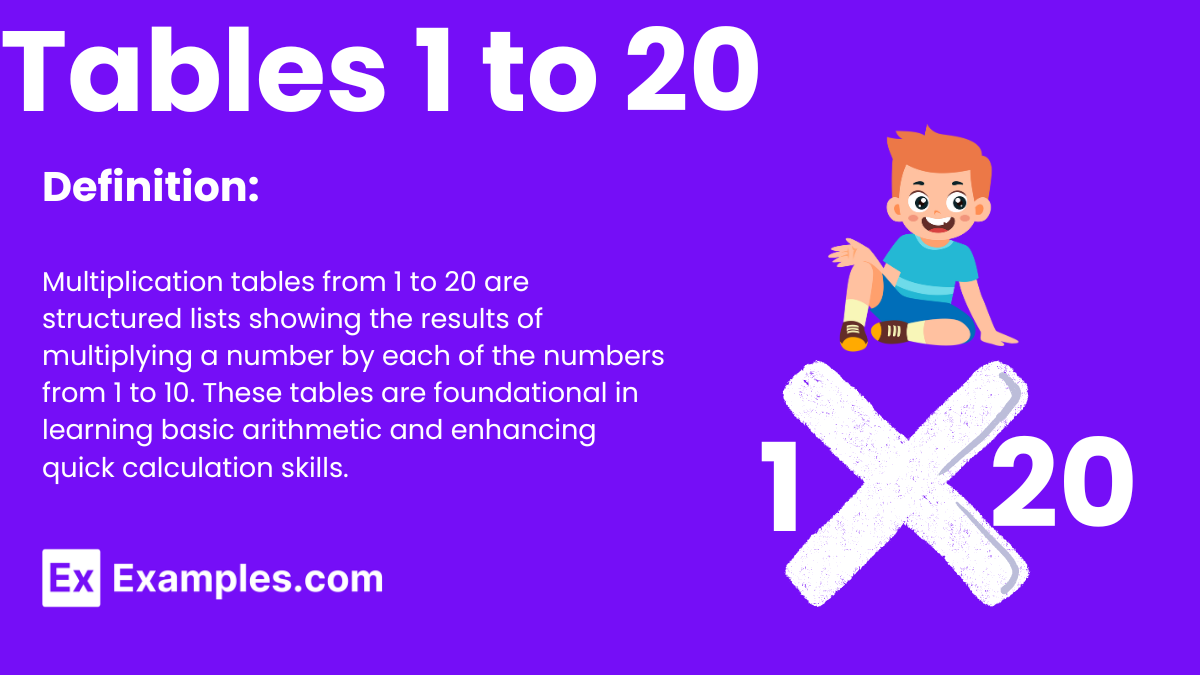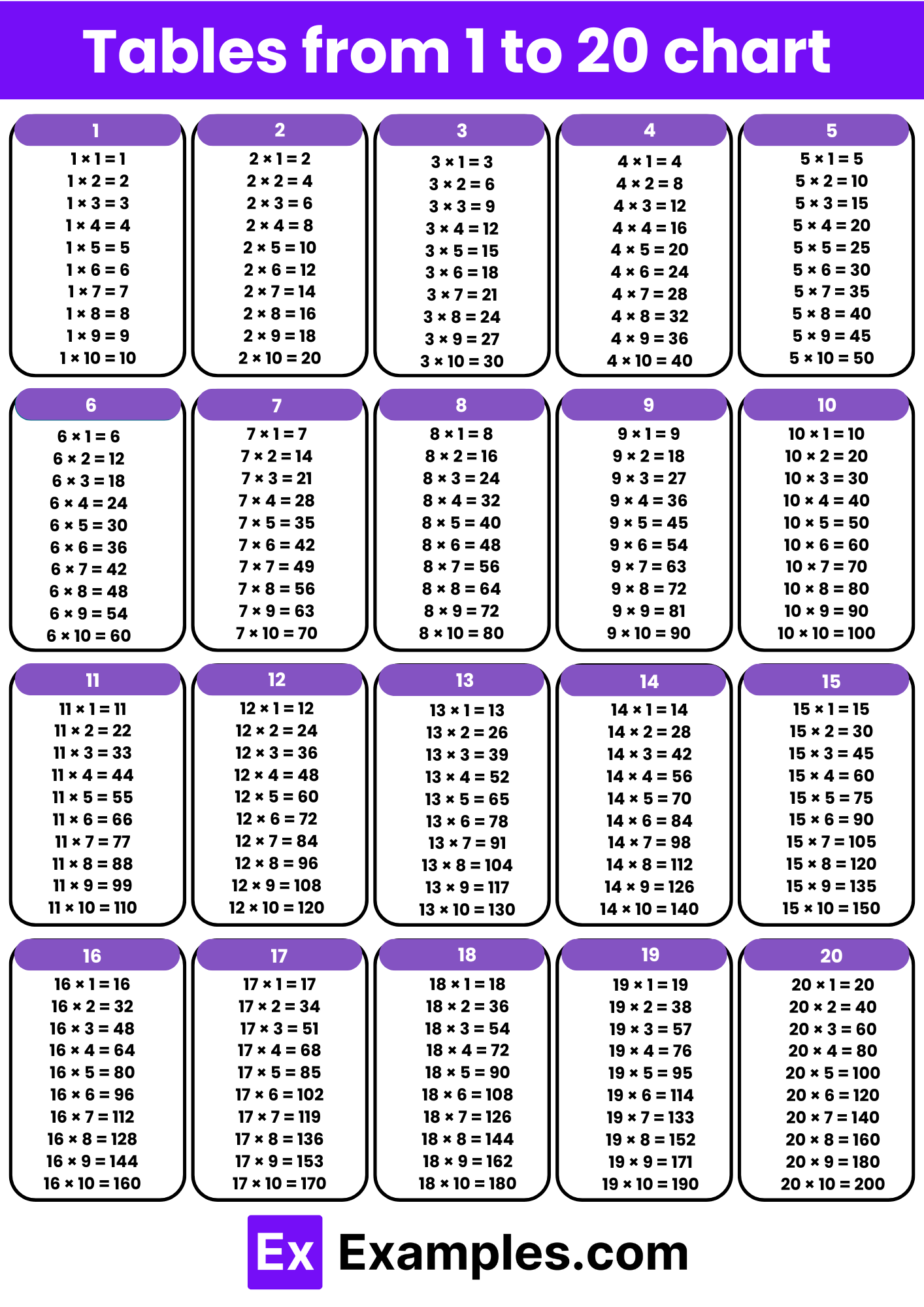What is the product of 7 and 12?
82
84
86
88


The multiplication tables from 1 to 20 form a fundamental part of early mathematics education, providing the basis for arithmetic operations and more complex math concepts. Mastering these tables enhances a student’s ability to perform multiplication quickly and accurately, which is crucial for solving problems in fractions, percentages, and algebra later on. Each table lists the products of numbers from 1 up to 20 multiplied by each number in that range, serving as an essential tool for building confidence and proficiency in math.

A multiplication chart from 1 to 20 displays the results of multiplying numbers between 1 and 20 with each other, forming a 20×20 grid. Each row and column header represents numbers 1 through 20, and the intersections provide the products. This comprehensive chart serves as a valuable reference tool, aiding in quick multiplication and reinforcing the concept of mathematical arrays and matrix operations.
| Table 1 | Table 2 | Table 3 | Table 4 | Table 5 |
| Table 6 | Table 7 | Table 8 | Table 9 | Table 10 |
| Table 11 | Table 12 | Table 13 | Table 14 | Table 15 |
| Table 16 | Table 17 | Table 18 | Table 19 | Table 20 |
| 1 x 1 = 1 | 2 x 1 = 2 | 3 x 1 = 3 | 4 x 1 = 4 | 5 x 1 = 5 |
| 1 x 2 = 2 | 2 x 2 = 4 | 3 x 2 = 6 | 4 x 2 = 8 | 5 x 2 = 10 |
| 1 x 3 = 3 | 2 x 3 = 6 | 3 x 3 = 9 | 4 x 3 = 12 | 5 x 3 = 15 |
| 1 x 4 = 4 | 2 x 4 = 8 | 3 x 4 = 12 | 4 x 4 = 16 | 5 x 4 = 20 |
| 1 x 5 = 5 | 2 x 5 = 10 | 3 x 5 = 15 | 4 x 5 = 20 | 5 x 5 = 25 |
| 1 x 6 = 6 | 2 x 6 = 12 | 3 x 6 = 18 | 4 x 6 = 24 | 5 x 6 = 30 |
| 1 x 7 = 7 | 2 x 7 = 14 | 3 x 7 = 21 | 4 x 7 = 28 | 5 x 7 = 35 |
| 1 x 8 = 8 | 2 x 8 = 16 | 3 x 8 = 24 | 4 x 8 = 32 | 5 x 8 = 40 |
| 1 x 9 = 9 | 2 x 9 = 18 | 3 x 9 = 27 | 4 x 9 = 36 | 5 x 9 = 45 |
| 1 x 10 = 10 | 2 x 10 = 20 | 3 x 10 = 30 | 4 x 10 = 40 | 5 x 10 = 50 |
| 6 x 1 = 6 | 7 x 1 = 7 | 8 x 1 = 8 | 9 x 1 = 9 | 10 x 1 = 10 |
| 6 x 2 = 12 | 7 x 2 = 14 | 8 x 2 = 16 | 9 x 2 = 18 | 10 x 2 = 20 |
| 6 x 3 = 18 | 7 x 3 = 21 | 8 x 3 = 24 | 9 x 3 = 27 | 10 x 3 = 30 |
| 6 x 4 = 24 | 7 x 4 = 28 | 8 x 4 = 32 | 9 x 4 = 36 | 10 x 4 = 40 |
| 6 x 5 = 30 | 7 x 5 = 35 | 8 x 5 = 40 | 9 x 5 = 45 | 10 x 5 = 50 |
| 6 x 6 = 36 | 7 x 6 = 42 | 8 x 6 = 48 | 9 x 6 = 54 | 10 x 6 = 60 |
| 6 x 7 = 42 | 7 x 7 = 49 | 8 x 7 = 56 | 9 x 7 = 63 | 10 x 7 = 70 |
| 6 x 8 = 48 | 7 x 8 = 56 | 8 x 8 = 64 | 9 x 8 = 72 | 10 x 8 = 80 |
| 6 x 9 = 54 | 7 x 9 = 63 | 8 x 9 = 72 | 9 x 9 = 81 | 10 x 9 = 90 |
| 6 x 10 = 60 | 7 x 10 = 70 | 8 x 10 = 80 | 9 x 10 = 90 | 10 x 10 = 100 |
| 11 x 1 = 11 | 12 x 1 = 12 | 13 x 1 = 13 | 14 x 1 = 14 | 15 x 1 = 15 |
| 11 x 2 = 22 | 12 x 2 = 24 | 13 x 2 = 26 | 14 x 2 = 28 | 15 x 2 = 30 |
| 11 x 3 = 33 | 12 x 3 = 36 | 13 x 3 = 39 | 14 x 3 = 42 | 15 x 3 = 45 |
| 11 x 4 = 44 | 12 x 4 = 48 | 13 x 4 = 52 | 14 x 4 = 56 | 15 x 4 = 60 |
| 11 x 5 = 55 | 12 x 5 = 60 | 13 x 5 = 65 | 14 x 5 = 70 | 15 x 5 = 75 |
| 11 x 6 = 66 | 12 x 6 = 72 | 13 x 6 = 78 | 14 x 6 = 84 | 15 x 6 = 90 |
| 11 x 7 = 77 | 12 x 7 = 84 | 13 x 7 = 91 | 14 x 7 = 98 | 15 x 7 = 105 |
| 11 x 8 = 88 | 12 x 8 = 96 | 13 x 8 = 104 | 14 x 8 = 112 | 15 x 8 = 120 |
| 11 x 9 = 99 | 12 x 9 = 108 | 13 x 9 = 117 | 14 x 9 = 126 | 15 x 9 = 135 |
| 11 x 10 = 110 | 12 x 10 = 120 | 13 x 10 = 130 | 14 x 10 = 140 | 15 x 10 = 150 |
| 16 x 1 = 16 | 17 x 1 = 17 | 18 x 1 = 18 | 19 x 1 = 19 | 20 x 1 = 20 |
| 16 x 2 = 32 | 17 x 2 = 34 | 18 x 2 = 36 | 19 x 2 = 38 | 20 x 2 = 40 |
| 16 x 3 = 48 | 17 x 3 = 51 | 18 x 3 = 54 | 19 x 3 = 57 | 20 x 3 = 60 |
| 16 x 4 = 64 | 17 x 4 = 68 | 18 x 4 = 72 | 19 x 4 = 76 | 20 x 4 = 80 |
| 16 x 5 = 80 | 17 x 5 = 85 | 18 x 5 = 90 | 19 x 5 = 95 | 20 x 5 = 100 |
| 16 x 6 = 96 | 17 x 6 = 102 | 18 x 6 = 108 | 19 x 6 = 114 | 20 x 6 = 120 |
| 16 x 7 = 112 | 17 x 7 = 119 | 18 x 7 = 126 | 19 x 7 = 133 | 20 x 7 = 140 |
| 16 x 8 = 128 | 17 x 8 = 136 | 18 x 8 = 144 | 19 x 8 = 152 | 20 x 8 = 160 |
| 16 x 9 = 144 | 17 x 9 = 153 | 18 x 9 = 162 | 19 x 9 = 171 | 20 x 9 = 180 |
| 16 x 10 = 160 | 17 x 10 = 170 | 18 x 10 = 180 | 19 x 10 = 190 | 20 x 10 = 200 |
Problem:
2 x 8 = ?
Solution:
2 x 8 = 16
(Multiplying 2 by 8 results in 16.)
Problem:
5 x 5 = ?
Solution:
5 x 5 = 25
(Five multiplied by five equals twenty-five.)
Problem:
7 x 9 = ?
Solution:
7 x 9 = 63
(Seven times nine gives sixty-three.)
Problem:
10 x 10 = ?
Solution:
10 x 10 = 100
(Ten multiplied by ten is one hundred.)
Problem:
12 x 6 = ?
Solution:
12 x 6 = 72
(Twelve times six results in seventy-two.)
Problem:
15 x 4 = ?
Solution:
15 x 4 = 60
(Fifteen multiplied by four equals sixty.)
Problem:
17 x 3 = ?
Solution:
17 x 3 = 51
(Seventeen times three gives fifty-one.)
Problem:
18 x 7 = ?
Solution:
18 x 7 = 126
(Eighteen multiplied by seven results in one hundred twenty-six.)
Problem:
19 x 5 = ?
Solution:
19 x 5 = 95
(Nineteen times five equals ninety-five.)
Problem:
20 x 8 = ?
Solution:
20 x 8 = 160
(Twenty multiplied by eight results in one hundred sixty.)
Learning multiplication tables is essential as it forms the basis for various mathematical concepts and calculations. It helps in developing strong arithmetic skills and facilitates quicker problem-solving.
Memorizing multiplication tables can be made easier by practicing regularly, using mnemonic devices, visual aids, and breaking down larger numbers into smaller factors.
Teaching multiplication tables can be made fun and engaging by using games, activities, and hands-on methods. Incorporating visual aids, songs, and stories can also help in making learning more enjoyable for children.
Some common patterns in multiplication tables include repeated digits, increasing sequences, and relationships between factors. Using skip counting, identifying multiples, and recognizing symmetry can also aid in memorization.
The age at which children are expected to know their multiplication tables can vary, but most students typically begin learning them in elementary school, around the ages of 7 to 9. Mastery of multiplication tables is usually expected by the end of elementary school.
Text prompt
Add Tone
10 Examples of Public speaking
20 Examples of Gas lighting
What is the product of 7 and 12?
82
84
86
88
If 15 is multiplied by which number, the result is 225?
12
13
14
15
Which of the following is not a multiple of 16?
48
64
72
88
What number should be multiplied with 18 to get 324?
16
17
18
19
If 20 times a number equals 300, what is the number?
12
13
14
15
What is the product of 11 and the sum of 4 and 6?
100
110
120
130
How many times does 14 fit into 196?
12
13
14
15
Which of the following numbers is a multiple of 19?
171
173
175
177
What is the missing number: 9 × _ = 162?
17
18
19
20
Which of the following is not a multiple of 10?
80
90
95
100
Before you leave, take our quick quiz to enhance your learning!

